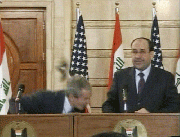
|
|
Donated shoes labeled with names of Iraqis who died during the war in Iraq are displayed during a protest in front of the White House in Washington December 17, 2008. REUTERS/Molly Riley |
But others, especially many in the Arab world, might recall another event where flying shoes made the front pages.
It was September 28, 2000. Then opposition candidate to become Israeli prime minister, Ariel Sharon, decided to take a “stroll” to the al-Aqsa mosque in Jerusalem, one of Islam’s holiest sites. He claimed the move was not meant to be provocative, and that he was just taking a walk “to see what happens here.” However, the previous decade, there had been at least two incidents during which Jewish Israelis threatened the mosque compound and Israeli forces carried out several mass killings of worshippers, and Palestinians revolted leading to the death of nearly 100 Palestinians by Israeli forces.
Sharon’s provocation led to clashes between Palestinian worshippers and more than 1,000 of Sharon’s occupation forces who just so happened to be in the area and armed with rubber coated steel bullets, tear gas and full riot gear. The Palestinian worshippers on the other hand were armed with their shoes. Images of this incident made it around the world as worshippers flung shoes at the Israeli occupation forces. The reaction to Sharon’s visit quickly spread throughout the Occupied Palestinian Territories, as Palestinians en masse took to the streets. Israel’s response, gunning down dozens of unarmed Palestinian protestors in a few days, led to years of violence. This incident led to what many say was the incident that ignited the second Palestinian intifada, while after leaving al-Aqsa, Sharon arrogantly claimed, “There was no provocation here.”
A move of such arrogance could only be matched by Sharon’s good friend eight years later.
After five years of war that ousted a dictator and replaced him with blood-filled chaos and an American occupation more deadly than the invasion, war-maker Bush made a surprise final visit to Baghdad and claimed yet again that the war “is decisively on its way to being won.” It was upon hearing these words that Iraqi journalist Muntadher al-Zaidi stood up and like those confronted with Sharon’s provocation, threw whatever he had on him that could be easily made into a projectile. Al-Zaidi was also sure to send a verbal attachment with the shoes when he shouted in Arabic, “this is a goodbye kiss, you dog!”
Had more Iraqi civilians been allowed into the press conference, we can be sure that most of their shoes, keys, cell phones and whatever else they had on them would’ve also landed on the stage. But they weren’t and instead they’ve taken to the streets of Baghdad and elsewhere around the country to demand al-Zaidi’s release. Reports have also emerged of U.S. military convoys, in the latest round of Iraqi insurgency, being shoed by Iraqi civilians.
What can a shoe do when thrown against the side of a heavily armored U.S. military vehicle? Make a loud thud. Perhaps some dirt from the shoe might come off and stay on the vehicle.
Shoes are a weapon of the masses. The fact is that most do not have the means to defend against their foreign invaders equipped with superior American-made weaponry. Shoes, like stones and most other projectiles used by the masses, are not about defeating or causing physical damage to the enemy. It is a symbolic act, and one filled with anger. It is a clear and simple message from the people to the occupiers that they are not welcome. And it is a message that the occupiers and their media so arrogantly refuse to admit.
It was an image seen throughout the world as Iraqis and much of the world opposed to the U.S.-led war applauded. On the following day in Cairo, a man walking through an outdoor cafe where I was sitting encouraged people to buy the newspapers on the back of his bicycle by shouting, “Al-Zaidi throws shoes at Bush!” Egyptians circled the man to purchase copies of the paper as they laughed and cheered at what have become historic images of al-Zaidi taking aim and Bush’s blurred head dodging the flying shoe.
But why did Western media constantly explain that shoe throwing is considered offensive in Arab culture? Unlike the entire Western media, I’m not going to claim to know the answer to this great cultural phenomenon. Maybe it’s not a phenomenon at all. Maybe it is what any of us would do if someone as arrogant as Ariel Sharon or George W. Bush visited the place that they’ve brutalized for years.
I would’ve liked an explanation then of the significance of eggs in American culture and what it meant when one was hurled at Bush’s motorcade during his inauguration in 2001. Many hungry Palestinians or Iraqis might view an egg as too valuable a resource to waste by throwing at a despised politician. Or what about an explanation for the pie-in-the-face tactic commonly used by activists to humiliate someone they do not agree with? Or what about vegetables? I remember as a kid always watching cartoons or films in which performers would have vegetables, especially big juicy tomatoes, hurled at them if they did a poor job. So why is it so hard for a culture that brings rotten vegetables to a theater in order to throw them in the event that the singer was off key, to need an explanation about why someone would remove his shoes and throw them at Bush?
Even Bush himself seems to have understood the gist of the message without the media’s cultural interpretations when he responded to a reporter who asked about the incident, “It’s like driving down the street and having people not gesturing with all five fingers.”
Could it be that Iraqis and Palestinians aren’t as armed and violent as they’re portrayed, and that the shoe is just something that everyone is armed, or rather footed with, and can easily be thrown? Perhaps, but when described in the U.S. it always has to be exaggerated to fit into Bush’s simplistic equation that “they” are so much different than “us.”
Like 2000 in Jerusalem or 2008 in Baghdad, shoeing incidents are most likely not premeditated. Forget the cultural differences when it comes to the meaning of shoes for a moment and focus on the real question: will an occupied people ever accept their occupiers? There is no more straightforward answer to this question than a shoe whizzing past the U.S. president’s head.
Matthew Cassel is assistant editor of The Electronic Intifada, from which this article was reprinted.






Leave a Reply